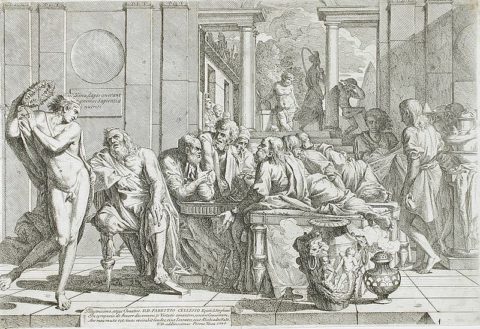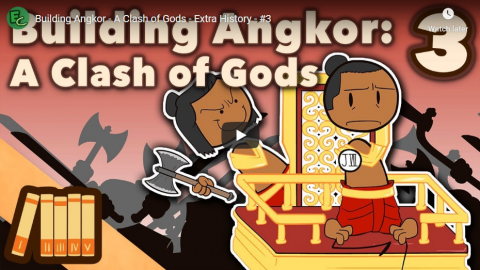The History Guy: History Deserves to Be Remembered
Published 29 Sep 2017The History Guy remembers how decolonization led to proxy war and the Battle of Dien Bien Phu in what is now known as Vietnam.
The episode discusses and presents historical photographs and film footage depicting events during a period of war, which some viewers may find disturbing. All events are described for educational purposes and are presented in historical context.
The History Guy uses images that are in the Public Domain. As photographs of actual events are often not available, I will sometimes use photographs of similar events or objects for illustration.
Patreon: https://www.patreon.com/TheHistoryGuy
The History Guy: Five Minutes of History is the place to find short snippets of forgotten history from five to fifteen minutes long. If you like history too, this is the channel for you.
Awesome The History Guy merchandise is available at:
https://teespring.com/stores/the-hist…The episode is intended for educational purposes. All events are presented in historical context.
#DienBienPhu #militaryhistory #thehistoryguy
November 1, 2021
Indochina and The Battle of Dien Bien Phu
January 22, 2021
Japan’s Only Pacific “Ally” – Phibun’s Thailand – WW2 Biography Special
World War Two
Published 21 Jan 2021Thailand’s prime minister and de-facto dictator Plaek Phibunsongkhram imported European fascism, nationalism and militarism to his country. But when Japan’s threat to South-East Asia became imminent, Phibun didn’t know what to do. His story is one of utter indecisiveness and opportunism.
Join us on Patreon: https://www.patreon.com/TimeGhostHistory
Or join The TimeGhost Army directly at: https://timeghost.tvFollow WW2 day by day on Instagram @ww2_day_by_day – https://www.instagram.com/ww2_day_by_day
Between 2 Wars: https://www.youtube.com/playlist?list…
Source list: http://bit.ly/WW2sourcesHosted by: Indy Neidell
Written by: Joram Appel
Director: Astrid Deinhard
Producers: Astrid Deinhard and Spartacus Olsson
Executive Producers: Astrid Deinhard, Indy Neidell, Spartacus Olsson, Bodo Rittenauer
Creative Producer: Maria Kyhle
Post-Production Director: Wieke Kapteijns
Research by: Joram Appel
Edited by: Miki Cackowski
Sound design: Marek Kamiński
Map animations: Eastory (https://www.youtube.com/c/eastory)Sources:
IWM HU 675
Portrait of Plaek Phibunsongkhram, courtesy of 冯銮披汶 https://commons.wikimedia.org/wiki/Fi…
From the Noun Project: people by ProSymbols, tick by akash kSoundtracks from the Epidemic Sound:
Johannes Bornlof – “Deviation In Time”
Philip Ayers – “Trapped in a Maze”
Rannar Sillard – “March Of The Brave 4”
Fabien Tell – “Last Point of Safe Return”
Johannes Bornlof – “The Inspector 4”
Farrell Wooten – “Blunt Object”Archive by Screenocean/Reuters https://www.screenocean.com.
A TimeGhost chronological documentary produced by OnLion Entertainment GmbH.
June 17, 2020
November 12, 2019
Building Angkor – The “Lost” City – Extra History – #5
Extra Credits
Published 8 Nov 2019Join us on Patreon! http://bit.ly/EHPatreon
After its decline, Angkor had become the Ancient, Lost City so prominent in our pop culture. Just one problem: Angkor was neither ancient (having declined around the same time as Hundred Years War) nor lost (people still lived there!). That didn’t stop the European visitors from trying to invent all kinds of stories for how this city could possibly exist, and stealing parts of the temple to bring back home. But despite all the hardships Angkor faced, it managed to become a national symbol for Cambodia and still remains to this day.
November 3, 2019
Building Angkor – A Drowning City – Extra History – #4
Extra Credits
Published 2 Nov 2019Join us on Patreon! http://bit.ly/EHPatreon
We’ve talked about the magnificence of Angkor at its peak, but how did this sprawling metropolis become a city of ruins? The city of Angkor depended on the reliability of the seasonal monsoon. Several decades of drought left them with little choice than to modify the whole water system. But when the waters returned, they returned in force. As did enemy forces. Thus begins the death spiral of the city of Angkor.
From the comments:
Extra Credits
1 day ago
Always 👏 maintain 👏 your 👏 water 👏 infrastructure !!!
October 29, 2019
Building Angkor – A Clash of Gods – Extra History – #3
Extra Credits
Published 26 Oct 2019Join us on Patreon! http://bit.ly/EHPatreon
Jayavarman VII, a Buddhist pacifist, was forced to give up his pacifism and rise to the throne at the age of 60. But once seated on the throne, he built Angkor Thom. The architecture was a fusion of buddhist and hindu stylings and included a comprehensive medical system. But will Angkor be able to stand after Jayavarman VII has passed?
Jayavarman VII the Great may be known as the greatest ruler of the Khmer, but he also wins the award for history’s best son. Making your mom the face for the goddess of wisdom is quite the Mother’s Day gift.
(Since folks have been asking for the metric conversions on our videos, 9 miles = 14.5 km at 4:52)
October 21, 2019
Building Angkor – Temple City – Extra History – #2
Extra Credits
Published 19 Oct 2019Join us on Patreon! http://bit.ly/EHPatreon
Let’s take a little tour around Suryavarman II crowning achievement, the temple that took only 33 years to complete, while Europeans were taking centuries to build their cathedrals. With a two mile long wall, gates large enough to allow elephants to pass and steps so steep that the average person needed to climb them like a ladder, Angkor Wat’s every feature was made to be impressive. But what lies at the heart might be surprising…
October 13, 2019
Building Angkor – Monsoon Metropolis – Extra History – #1
Extra Credits
Published 12 Oct 2019Join us on Patreon! http://bit.ly/EHPatreon
Let’s lay down the foundations for one of the architectural marvels of the ancient world: At its height, the city of Angkor was, by several measures, the largest city of the medieval era. With a million people and a footprint larger than modern-day New York, it was arguably the world’s largest pre-industrial city. And at its center lay the magnificent Angkor Wat.
April 18, 2018
QotD: The United Nations
It’s a good basic axiom that if you take a quart of ice-cream and a quart of dog faeces and mix ’em together the result will taste more like the latter than the former. That’s the problem with the UN. If you make the free nations and the thug states members of the same club, the danger isn’t that they’ll meet each other half-way but that the free world winds up going three-quarters, seven-eighths of the way. Thus the Oil-for-Fraud scandal: in the end, Saddam Hussein had a much shrewder understanding of the way the UN works than Bush and Blair did.
And, of course, corrupt organisations rarely stop at just one kind. If you don’t want to bulk up your pension by skimming the Oil-for-Food programme, don’t worry, whatever your bag, the UN can find somewhere that suits — in West Africa, it’s Sex-for-Food, with aid workers demanding sexual services from locals as young as four; in Cambodia, it’s drug dealing; in Kenya, it’s the refugee extortion racket; in the Balkans, sex slaves.
Mark Steyn, “UN forces — just a bunch of thugs?”, Telegraph Online 2005-02-15
August 20, 2016
QotD: Violence in wartime – the great exception
War is the great exception, the great legitimizer of murder, the one arena in which ordinary humans routinely become killers. The special prevalence of the killer-ape myth in our time doubtless owes something to the horror and visibility of 20th-century war.
Campaigns of genocide and repressions such as the Nazi Holocaust, Stalin’s engineered famines, the Ankha massacres in Cambodia, and “ethnic cleansing” in Yugoslavia loom even larger in the popular mind than war as support for the myth of man the killer. But they should not; such atrocities are invariably conceived and planned by selected, tiny minorities far fewer than 0.5% of the population.
We have seen that in normal circumstances, human beings are not killers; and, in fact, most have instincts which make it extremely difficult for them to engage in lethal violence. How do we reconcile this with the continuing pattern of human violence in war? And, to restate to one of our original questions, what is belief in the myth of man the killer doing to us?
We shall soon see that the answers to these two questions are intimately related — because there is a crucial commonality between war and genocide, one not shared with the comparatively negligible lethalities of criminals and the individually insane. Both war and genocide depend, critically, on the habit of killing on orders. Pierson observes, tellingly, that atrocities “are generally initiated by overcontrolled personality types in second-in-command positions, not by undercontrolled personality types.” Terrorism, too, depends on the habit of obedience; it is not Osama bin Laden who died in the 9/11 attack but his minions.
This is part of what Hannah Arendt was describing when, after the Nuremberg trials, she penned her unforgettable phrase “the banality of evil”. The instinct that facilitated the atrocities at Belsen-Bergen and Treblinka and Dachau was not a red-handed delight in murder, but rather uncritical submission to the orders of alpha males — even when those orders were for horror and death.
Human beings are social primates with social instincts. One of those instincts is docility, a predisposition to obey the tribe leader and other dominant males. This was originally adaptive; fewer status fights meant more able bodies in the tribe or hunting band. It was especially important that bachelor males, unmarried 15-to-25 year-old men, obey orders even when those orders involved risk and killing. These bachelors were the tribe’s hunters, warriors, scouts, and risk-takers; a band would flourish best if they were both aggressive towards outsiders and amenable to social control.
Over most of human evolutionary history, the multiplier effect of docility was limited by the small size (250 or less, usually much less) of human social units. But when a single alpha male or cooperating group of alpha males could command the aggressive bachelor males of a large city or entire nation, the rules changed. Warfare and genocide became possible.
Actually, neither war nor genocide needs more than a comparative handful of murderers — not much larger a cohort than the half-percent to percent that commits lethal violence in peacetime. Both, however, require the obedience of a large supporting population. Factories must work overtime. Ammunition trucks must be driven where the bullets are needed. People must agree not to see, not to hear, not to notice certain things. Orders must be obeyed.
Eric S. Raymond, “The Myth of Man the Killer”, Armed and Dangerous, 2003-07-15.
June 17, 2014
Somaly Mam’s Icarus turn
In Taki’s Magazine, Kathy Shaidle describes the rise and fall of Somaly Mam, who is the most recent fantasist to dupe Westerners about conditions in her home country:
One of the last thrills still permitted us normal folks (for now) is getting to watch one of these self-appointed activists and advocates endure an Icarian tumble. Take that recent Newsweek exposé of secular saint and “sex work” abolitionist Somaly Mam.
No, I’d never heard of her before, either. I didn’t realize how far removed I was from what the authorities have deemed reality until I read that, among other things, this woman had been feted by the White House and the State Department, appeared on The Oprah Winfrey Show, made the “TIME 100” list, and declared one of Glamour’s “Women of the Year.” Plus she’d been named one of the “Women Who Shake the World” by, er, Newsweek.
Cambodian-born Somaly Mam began making claims she’d been sold into sexual slavery as a youngster. After a daring escape, she dedicated her life to rescuing other girls from the same fate, leading armed raids on brothels, then providing shelter, education, and vocational training to the former captives—with the help of Western donors, many of them celebrities.
Aaaaaaannnnnddddd … ? Oh, come on. Guess.
Simon Marks has been investigating Mam for The Cambodia Daily (“All the News Without Fear or Favor”) for years. When Newsweek ran his findings in that cover story last month, the rest of the world found out what actual Cambodians and NGO-types have been trying to tell us all this time:
Mam’s “origin story” is mostly bollocks on stilts.
Her “rescues” are more like kidnappings, and her statistics about Cambodia’s trafficking rates, exaggerated. She coached non-ex-prostitutes to tell hair-raising tales of rape, torture, and even eye-gouging when pale-faced documentarians came calling. “[I]nstead of a brothel or a massage parlour,” Mam’s “rescued slaves” ended up “working for poverty-level wages in unsafe and exploitative conditions in sweatshops.”











